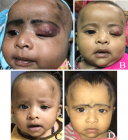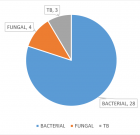Abstract
Mini Review
The use of Allergoids and Adjuvants in Allergen Immunotherapy
Celso Eduardo Olivier*
Published: 20 September, 2017 | Volume 1 - Issue 1 | Pages: 040-060
Allergen immunotherapy (AIT) is the unique curative treatment to help allergic patients to get over their allergies. With a personalized approach, AIT is the best example of precision medicine. After a century of intensive studies and innovative discoveries, allergists have in their hands many tools to orchestrate the best strategy to re-educate the hypersensitive immune systems that decrease the quality of life of their patients. This review describes both the historical and the promising acquisitions in this field, focusing the biochemical and Bioengineering tools that render an allergen more suitable for a secure, convenient and effective immunotherapy.
Read Full Article HTML DOI: 10.29328/journal.haard.1001006 Cite this Article Read Full Article PDF
Keywords:
Allergens; Allergoid; Allergists; Bioengineering; Hypersensitivity; Immunologic desensitization; Immune system; Polymerization; Precision medicine
References
- Akdis CA, Akdis Mb. Mechanisms of allergen-specific immunotherapy. J Allergy Clin Immunol. 2011; 127: 18-27. Ref.: https://goo.gl/tfh5HN
- Curtis H. The immunization treatment of hay fever. JAMA. 1902; 39: 1267-1268. Ref.: https://goo.gl/djxtrJ
- Besredka A. De l'anaphylaxie. Sixiéme memoire de l'anaphylaxie lactique. Ann Inst Pasteur. 1909; 23: 166-174.
- Cobbold SP, Li XC. Translating Tolerogenic Therapies to the Clinic. Where Do We Stand and What are the Barriers? Front Immunol. 2012; 3: 317. Ref.: https://goo.gl/5sV5St
- Faria AM, Weiner HL. Oral tolerance. Immunol Rev. 2005; 206: 232-259. Ref.: https://goo.gl/R7ZrtR
- Verheggen BG, Westerhout KY, Schreder CH, Augustin M. Health economic comparison of SLIT allergen and SCIT allergoid immunotherapy in patients with seasonal grass-allergic rhinoconjunctivitis in Germany. Clin Transl Allergy. 2015; 5: 1. Ref.: https://goo.gl/ySkzNy
- Winther L, Arnved J, Malling HJ, Nolte H, Mosbech H. Side-effects of allergen-specific immunotherapy. A prospective multi-centre study. Clin Exp Allergy. 2006; 36: 254-260. Ref.: https://goo.gl/7P6pG1
- Olivier CE, Lima RPS, Argentão DGP, Silva MDd, Santos RAPG, et al. Group-specific Multi-allergen Sublingual/Swallow Immunotherapy Improves the Quality of Life of Polysensitized Children and Adults with Allergic Rhinitis. Journal of Allergy & Therapy. 2013; 4: 148. Ref.: https://goo.gl/3YGw5T
- Klimek L, Bachmann MF, Senti G, Kündig TM. Immunotherapy of type-1 allergies with virus-like particles and CpG-motifsExpert Rev Clin Immunol. 2014; 10: 1059-1067. Ref.: https://goo.gl/8BU7dK
- Cox L, Nelson H, Lockey R, Calabria C, Chacko T, et al. Allergen immunotherapy: A practice parameter third update. J Allergy Clin Immunol. 2011; 127: 1-55. Ref.: https://goo.gl/DMZKZX
- Palomares O, Martin-Fontecha M, Lauener R, Traidl-Hoffmann C, Cavkaytar O, et al. Regulatory T cells and immune regulation of allergic diseases: roles of IL-10 and TGF-beta. Genes Immun. 2014; 15: 511-520. Ref.: https://goo.gl/rRUDoJ
- Bohle B, Kinaciyan T, Gerstmayr M, Radakovics A, Jahn-Schmid B, et al. Sublingual immunotherapy induces IL-10-producing T regulatory cells, allergen-specific T-cell tolerance, and immune deviation. J Allergy Clin Immunol. 2007; 120: 707-713. Ref.: https://goo.gl/9d5zKm
- van Neerven RJ, Knol EF, Ejrnaes A, Würtzen PA. IgE-Mediated Allergen Presentation and Blocking Antibodies: Regulation of T-Cell Activation in Allergy. Int Arch Allergy Immunol. 2006; 141: 119-129. Ref.: https://goo.gl/WEn3nJ
- van de Veen W, Akdis M. Role of IgG4 in IgE-mediated allergic responses. J Allergy Clin Immunol. 2016; 138: 1434-1435. Ref.: https://goo.gl/xBamCk
- van de Veen W, Stanic B, Wirz OF, Jansen K, Globinska A, et al. Role of regulatory B cells in immune tolerance to allergens and beyond. J Allergy Clin Immunol. 2016; 138: 654-665. Ref.: https://goo.gl/RkAGsz
- Noval Rivas M, Chatila TA. Regulatory T cells in allergic diseases. J Allergy Clin Immunol. 2016; 138: 639-652. Ref.: https://goo.gl/KTJB9v
- Till SJ, Francis JN, Nouri-Aria K, Durham SR. Mechanisms of immunotherapy. J Allergy Clin Immunol. 2004; 113: 1025-1034. Ref.: https://goo.gl/aG2qBv
- Favre L, Spertini F, Corthesy B. Secretory IgA Possesses Intrinsic Modulatory Properties Stimulating Mucosal and Systemic Immune Responses. J Immunol. 2005; 175: 2793-2800. Ref.: https://goo.gl/Tvr6jn
- Aalberse RC, Schuurman J. IgG4 breaking the rules. Immunology. 2002; 105: 9-19. Ref.: https://goo.gl/XCMzQS
- Focke M, Swoboda I, Marth K, Valenta R. Developments in allergen-specific immunotherapy: from allergen extracts to allergy vaccines bypassing allergen-specific immunoglobulin E and T cell reactivity. Clin Exp Allergy. 2010; 40: 385-397. Ref.: https://goo.gl/pxwjA8
- Himly M, Carnes J, Fernandez-Caldas E, Briza P, Ferreira F. Characterization of allergoids. Arb Paul Ehrlich Inst Bundesinstitut Impfstoffe Biomed Arzneim Langen Hess. 2009; 96: 61-69. Ref.: https://goo.gl/Kmp9mY
- Maasch H, Marsh D. Standardized extracts modified allergens-allergoids. Clin Rev Allergy. 1987; 5: 89-106. Ref.: https://goo.gl/2DJnDL
- Loewenstein E. Über aktive Schutzimpfung bei Tetanus durch Toxoide. Zeitschrift für Hygiene und Infektionskrankheiten. 1909; 62: 491-508. Ref.: https://goo.gl/XQMVkW
- Bousquet J, Maasch HJ, Hejjaoui A, Skassa-Brociek W, Wahl Rd, et al. Double-blind, placebo-controlled immunotherapy with mixed grass-pollen allergoids: III. Efficacy and safety of unfractionated and high-molecular-weight preparations in rhinoconjunctivitis and asthma. J Allergy Clin Immunol. 1989; 84: 546-556. Ref.: https://goo.gl/ZZ83hP
- Valenta R, Ferreira F, Focke-Tejkl M, Linhart B, Niederberger V, et al. From Allergen Genes to Allergy Vaccines. Annu Rev Immunol. 2010; 28: 211-241. Ref.: https://goo.gl/is9XQy
- Heath M, Bell A, Skinner M, Bullimore AD. Molecular Fingerprinting of Complex Allergoids. Journal of Allergy and Clinical Immunology. 2016; 137: 405. Ref.: https://goo.gl/3hn6tp
- Starchenka S, Bell AJ, Mwange J, Skinner MA, Heath MD. Molecular fingerprinting of complex grass allergoids: size assessments reveal new insights in epitope repertoires and functional capacities. World Allergy Organ J. 2017; 10: 17. Ref.: https://goo.gl/z1eanS
- Heath M, Starchenka S, Bell A, Skinner M. Structural and immunological characterisation of a broad-spectrum grass allergoid vaccine. Journal of Allergy and Clinical Immunology. 2017; 139: 259. Ref.: https://goo.gl/9cLRVL
- Marsh DG, Lichtenstein LM, Campbell DH. Studies on `allergoids' prepared from naturally occurring allergens: I. Assay of allergenicity and antigenicity of formalinized rye Group I component. Immunology. 1970; 18: 705-722. Ref.: https://goo.gl/Ni95rP
- Distler A, Pappelendam D. 13-year overview of serious adverse drug reactions following subcutaneous specific immunotherapy with a chemically modified allergen preparation. Allergo J Int. 2015; 24: 294-302. Ref.: https://goo.gl/XMYanV
- Pickl WF. The Value of Identifying Major T Cell Epitopes of Clinically Important Allergens. Int Arch Allergy Immunol. 2012; 160: 4-6. Ref.: https://goo.gl/UU2kBk
- Campbell JD, Buckland KF, McMillan SJ, Kearley J, Oldfield WLG, et al. Peptide immunotherapy in allergic asthma generates IL-10“dependent immunological tolerance associated with linked epitope suppression. J Exp Med. 2009; 206: 1535-1547. Ref.: https://goo.gl/ksBJbT
- Campana R, Moritz K, Marth K, Neubauer A, Huber H, et al. Frequent occurrence of T cell-mediated late reactions revealed by atopy patch testing with hypoallergenic rBet v 1 fragments. J Allergy Clin Immunol. 2016; 137: 601-609. Ref.: https://goo.gl/SHUYhp
- Ferreira F, Wolf M, Wallner M. Molecular Approach to Allergy Diagnosis and Therapy. Yonsei Med J. 2014; 55: 839-852. Ref.: https://goo.gl/oT5eqW
- Flower DR. Advances in Predicting and Manipulating the Immunogenicity of Biotherapeutics and Vaccines. BioDrugs. 2009; 23: 231-240. Ref.: https://goo.gl/hkWfmH
- Olivier CE, Argentão DGP, Santos RAPG, Silva MD, Lima RPS, et al. Skin scrape test: an inexpensive and painless skin test for recognition of immediate hypersensitivity in children and adults. The Open Allergy Journal. 2013; 6: 9-17. Ref.: https://goo.gl/XHJx2z
- Olivier CE, Argentão DG, Santos Lima RP, Santos RAGP, Fabbri N. Assessment of allergen-induced respiratory hyperresponsiveness before the prescription of a specific immunotherapy. Allergy Rhinol (Providence). 2015; 6: 89-93. Ref.: https://goo.gl/tJcbVM
- Gioacchino MD, Cavallucci E, Ballone E, Cervone M, Rocco PD, et al. Dose-Dependent Clinical and Immunological Efficacy of Sublingual Immunotherapy with Mite Monomeric Allergoid. Int J Immunopathol Pharmacol. 2012; 25: 671-679. Ref.: https://goo.gl/xrDSio
- Iraola V, Gallego MT, Lopez-Matas MA, Morales M, Bel I, et al. Immunogenicity of Phleum pratense depigmented allergoid vaccines: experimental study in rabbits. J Investig Allergol Clin Immunol. 2012; 22: 35-40. Ref.: https://goo.gl/crE4xR
- Olivier CE, Lima RPS, Pinto DG, Santos RAPG, Silva GKM, et al. In search of a tolerance-induction strategy for cow's milk allergies: significant reduction of beta-lactoglobulin allergenicity via transglutaminase/cysteine polymerization. Clinics (Sao Paulo). 2012; 67: 1171-1179. Ref.: https://goo.gl/AS4Ntz
- Egger M, Jürets A, Wallner M, Briza P, Ruzek S, et al. Assessing Protein Immunogenicity with a Dendritic Cell Line-Derived Endolysosomal Degradome. PLoS One. 2011; 6: 17278. Ref.: https://goo.gl/5Ytj7Y
- Thomson DMP. Assessment of immune status by the leukocyte adherence inhibition test. New York: Academic Press; 1982. Ref.: https://goo.gl/CoMKWN
- Vanto T, Smogorzewska EM, Viander M, Kalimo K, Koivikko A. Leukocyte migration inhibition test in children with cow milk allergy. Allergy 1987; 42: 612-618. Ref.: https://goo.gl/gHfAHJ
- Moingeon P. Adjuvants for allergy vaccines. Hum Vaccin Immunother. 2012; 8: 1492-1498. Ref.: https://goo.gl/UbMQjZ
- Häfner D, Gödicke V, Narkus A. Allergen specific immunotherapy has no influence on standard chemistry and hematology laboratory parameters in clinical studies. Clin Transl Allergy. 2014; 4: 18. Ref.: https://goo.gl/qsWcvj
- Buczyłko K, van der Werf JF, Boot D, van Ree R. Accelerated Up-Dosing of Subcutaneous Immunotherapy with a Registered Allergoid Birch Pollen Preparation. Int Arch Allergy Immunol. 2017; 172: 183-186. Ref.: https://goo.gl/ACPT69
- Pfaar O, Lang S, Pieper-Fürst U, Astvatsatourov A, Gerich F, et al. Ultra-short-course booster is effective in recurrent grass pollen-induced allergic rhinoconjunctivitis. Allergy. 2017; 4: 13240. Ref.: https://goo.gl/tHDXJu
- Chaker AM, Al-Kadah B, Luther U, Neumann U, Wagenmann M. An accelerated dose escalation with a grass pollen allergoid is safe and well-tolerated: a randomized open label phase II trial. Clin Transl Allergy. 2016; 6: 4. Ref.: https://goo.gl/Be7XLh
- Morais-Almeida M, Arêde C, Sampaio G, Borrego LM. Ultrarush schedule of subcutaneous immunotherapy with modified allergen extracts is safe in paediatric age. Asia Pac Allergy. 2016; 6: 35-42. Ref.: https://goo.gl/PeD17K
- Noon L. Prophylatic inoculation against hay fever. The Lancet 1911; 177:1572-1573. Ref.: https://goo.gl/v9EHqm
- Cooke RA, Veer AV. Human Sensitization. The Journal of Immunology. 1916; 1: 201-305. Ref.: https://goo.gl/XBU9FK
- Schloss OM. A Case of Allergy to Common Foods. Am J Dis Child 1983; 41:249-252. Ref.: https://goo.gl/VHAoEQ
- Coca AF. Studies in Specific Hypersensitiveness V. The Preparation of Fluid Extracts and Solutions for Use in the Diagnosis and Treatment of the Allergies with Notes on the Collection of Pollens. The Journal of Immunology. 1922; 7: 163-178. Ref.: https://goo.gl/VmhWy6
- Van Metre Jr TE, Rosenberg GL, Vaswani SK, Ziegler SR, Adkinson NF. Pain and dermal reaction caused by injected glycerin in immunotherapy solutions. J Allergy Clin Immunol. 1996; 97: 1033-1039. Ref.: https://goo.gl/fvcFoV
- Daigle BJ, Rekkerth DJ. Practical recommendations for mixing allergy immunotherapy extracts. Allergy Rhinol (Providence). 2015; 6: 1-7. Ref.: https://goo.gl/GQ266R
- Slater JE, Menzies SL, Bridgewater J, Mosquera A, Zinderman CE, et al. The US Food and Drug Administration review of the safety and effectiveness of nonstandardized allergen extracts. J Allergy Clin Immunol. 2012; 129: 1014-1019. Ref.: https://goo.gl/jT6dv2
- Fernández-Caldas E, Gallego M, Carnés J, Iraola V. Enzymatic Activity of Dermatophagoides pteronyssinus extracts after acidic treatment. Int Arch Allergy Immunol. 2008; 145: 298-304. Ref.: https://goo.gl/azdfme
- Iraola VM, Leonor JR, Morales M, López Matas MA, Gallego MT, Carnés J. Enzymatic Activity of Grass Native Allergenic Extracts Is Eliminated in Depigmented Allergoids. Journal of Allergy and Clinical Immunology. 2013; 131: 110. Ref.: https://goo.gl/Eei5fQ
- Pfaar O, Sager A, Robinson DS. Safety and effect on reported symptoms of depigmented polymerized allergen immunotherapy: a retrospective study of 2927 paediatric patients. Pediatr Allergy Immunol. 2015; 26: 280-286. Ref.: https://goo.gl/EGN6rz
- Johansen P, Senti G, Gómez JMM, Wüthrich B, Bot A, et al. Heat denaturation, a simple method to improve the immunotherapeutic potential of allergens. Eur J Immunol. 2005; 35: 3591-3598. Ref.: https://goo.gl/9ryW7X
- Davis PJ, Williams SC. Protein modification by thermal processing. Allergy. 1998; 53: 102-105. Ref.: https://goo.gl/nxXkWm
- Hildebrandt S, Kratzin HD, Schaller R, Fritsché R, Steinhart H, et al. In Vitro Determination of the Allergenic Potential of Technologically Altered Hen's Egg. J Agric Food Chem. 2008; 56: 1727-1733. Ref.: https://goo.gl/Jhm5Bs
- Kim JS, Nowak-Wegrzyn A, Sicherer SH, Noone S, Moshier EL, et al. Dietary baked milk accelerates the resolution of cow's milk allergy in children. J Allergy Clin Immunol. 2011; 128: 125-131. Ref.: https://goo.gl/LtRSCy
- Beyer K, Morrow E, Li XM, Bardina L, Bannon GA, et al. Effects of cooking methods on peanut allergenicity. J Allergy Clin Immunol. 2001; 107: 1077-1081. Ref.: https://goo.gl/oXEDkY
- Naterman HL. Formalinized pollen tannate in desensitization treatment. J Allergy. 1957; 28: 76-83. Ref.: https://goo.gl/YTt7cF
- Ishizaka K, Okudaira H, King TP. Immunogenic Properties of Modified Antigen E - Ability of Urea-Denatured Antigen and alpha-Polypeptide Chain to Prime T Cells Specific for Antigen E. J Immunol. 1975; 114: 110-115. Ref.: https://goo.gl/yFPnWF
- Marsh DG, Norman PS, Roebber M, Lichtenstein LM. Studies on allergoids from naturally occurring allergens III. Preparation of ragweed pollen allergoids by aldehyde modification in two steps. J Allergy Clin Immunol. 1981; 68: 449-459. Ref.: https://goo.gl/V65UeX
- Avrameas S. Coupling of enzymes to proteins with glutaraldehyde. Immunochemistry. 1969; 6: 43-52.
- Avrameas S, Ternynck T. The Cross-linking of Proteins with Glutaraldehyde and its use for the preparation of immunoadsorbents. Immunochemistry. 1969; 6: 53-66. Ref.: https://goo.gl/65CFhq
- Haddad ZH, Marsh DG, Campbell DH. Studies on "allergoids" prepared from naturally occurring allergens II. Evaluation of allergenicity and assay of antigenicity of formalinized mixed grass pollen extracts. J Allergy Clin Immunol. 1972; 49: 197-209. Ref.: https://goo.gl/jn2uPK
- Urry ZL, Richards DF, Black C, Morales M, Carnes J, et al. Depigmented-polymerised allergoids favour regulatory over effector T cells: enhancement by 1-alpha, 25-dihydroxyvitamin D3. BMC Immunol. 2014; 15: 21. Ref.: https://goo.gl/PzdNDC
- Casanovas M, Gómez MJ, Carnés J, Fernández-Caldas E. Skin tests with native, depigmented and glutaraldehyde polymerized allergen extracts. J Invest Allergol Clin Immunol. 2005; 15: 30-36. Ref.: https://goo.gl/uU5k4H
- Norman PS, Lichtenstein LM, Marsh DG. Studies on allergoids from naturally occurring allergens. IV. Efficacy and safety of long-term allergoid treatment of ragweed hay fever. J Allergy Clin Immunol. 1981; 68: 460-470. Ref.: https://goo.gl/fs4jrx
- Kalinski P, Lebre MC, Kramer D, De Jong EC, Van Schijndel JW, et al. Analysis of the CD4+ T cell responses to house dust mite allergoid. Allergy. 2003; 58: 648-656. Ref.: https://goo.gl/yAjJuU
- Salgado J, Casadevall G, Puigneró V, Queralt J. Characterization of Allergoids from Ovalbumin in vitro and in vivo. Immunobiology. 1996; 196: 375-386. Ref.: https://goo.gl/nBiK4B
- Patterson R, Suszko IM, McIntire FC. Polymerized Ragweed Antigen E I. Preparation and Immunologic Studies. J Immunol. 1973; 110: 1402-1412. Ref.: https://goo.gl/us2gBc
- Patterson R, Suszko IM, Pruzansky JJ, Zeiss CR. Polymerized Ragweed Antigen E II. In vivo Elimination Studies and Reactivity with IgE Antibody Systems. J Immunol. 1973; 110: 1413-1418. Ref.: https://goo.gl/Kioi5r
- Patterson R, Suszko IM, Pruzansky JJ, Zeiss CR, Metzger WJ, et al. Polymerization of mixtures of grass allergens. J Allergy Clin Immunol. 1977; 59: 314-319. Ref.: https://goo.gl/LNeHnw
- Gallego MT, Iraola V, Himly M, Robinson DS, Badiola C, et al. Depigmented and polymerised house dust mite allergoid: allergen content, induction of IgG4 and clinical response. Int Arch Allergy Immunol. 2010; 153: 61-69. Ref.: https://goo.gl/N1GRGR
- HayGlass KT, Strejan GH. Antigen- and IgE class-specific suppression mediated by T suppressor cells of mice treated with glutaraldehyde-polymerized ovalbumin. Int Arch Allergy Appl Immunol. 1983; 71: 23-31. Ref.: https://goo.gl/eSGzdA
- Morales M, Gallego M, Iraola V, Taulés M, de Oliveira E, et al. In vitro evidence of efficacy and safety of a polymerized cat dander extract for allergen immunotherapy. BMC Immunol. 2017; 18: 10. Ref.: https://goo.gl/ovxFDV
- Heydenreich B, Bellinghausen I, Lorenz S, Henmar H, Strand D, et al. Reduced in vitro T-cell responses induced by glutaraldehyde-modified allergen extracts are caused mainly by retarded internalization of dendritic cells. Immunology. 2012; 136: 208-217. Ref.: https://goo.gl/aNcFTJ
- Villas-Boas MB, Vieira KP, Trevizan G, Zollner RL, Netto FM. The effect of transglutaminase-induced polymerization in the presence of cysteine on beta-lactoglobulin antigenicity. Int Dairy J. 2010; 20: 386-392. Ref.: https://goo.gl/RdN37z
- Hendrix S, Zeiss CR, Suszko I, Levitz D, Patterson R. Polymerized whole ragweed: An improved method of immunotherapy. J Allergy Clin Immunol. 1978; 62: 289-294. Ref.: https://goo.gl/vvK5Ys
- Mistrello G, Roncarolo D, Gentili M, Zanoni D, Falagiani P. Modified par j I allergen from P. judaica pollen and its rate of absorption in rats. Immunol Lett. 1994; 40: 31-36. Ref.: https://goo.gl/BrLzif
- Akdis CA, Barlan IB, Bahceciler N, Akdis M. Immunological mechanisms of sublingual immunotherapy. Allergy. 2006; 61: 11-14. Ref.: https://goo.gl/qixFuZ
- Manzano AI, Javier Cañada F, Cases B, Sirvent S, Soria I, et al. Structural studies of novel glycoconjugates from polymerized allergens (allergoids) and mannans as allergy vaccines. Glycoconj J. 2016; 33: 93-101. Ref.: https://goo.gl/5wwQQR
- Roger A, Depreux N, Jurgens Y, Heath MD, Garcia G, et al. A novel and well tolerated mite allergoid subcutaneous immunotherapy: evidence of clinical and immunologic efficacy. Immun Inflamm Dis. 2014; 2: 92-98. Ref.: https://goo.gl/kG9DuY
- Gokmen NM, Ersoy R, Gulbahar O, Ardeniz O, Sin A, et al. Desensitization effect of preseasonal seven-injection allergoid immunotherapy with olive pollen on basophil activation: the efficacy of olive pollen-specific preseasonal allergoid immunotherapy on basophils. Int Arch Allergy Immunol. 2012; 159: 75-82. Ref.: https://goo.gl/GvwL8J
- Pfaar O, Sager A, Robinson DS. Safety and effect on reported symptoms of depigmented-polymerised allergen immunotherapy: a retrospective study of 2927 paediatric patients. Pediatr Allergy Immunol. 2015. 26: 280-286. Ref.: https://goo.gl/cUsWgY
- Lozano J, Cruz MJ, Piquer M, Giner MT, Plaza AM. Assessing the Efficacy of Immunotherapy with a Glutaraldehyde-Modified House Dust Mite Extract in Children by Monitoring Changes in Clinical Parameters and Inflammatory Markers in Exhaled Breath. Int Arch Allergy Immunol. 2014; 165: 140-147. Ref.: https://goo.gl/QsZAFC
- Weinberger EE, Himly M, Myschik J, Hauser M, Altmann F, et al. Generation of hypoallergenic neoglycoconjugates for dendritic cell targeted vaccination: a novel tool for specific immunotherapy. J Control Release. 2013; 165: 101-109. Ref.: https://goo.gl/mL2YMf
- Aboumahmoud R, Savello P. Crosslinking of Whey Protein by Transglutaminase. J Dairy Sci. 1990; 73: 256-263. Ref.: https://goo.gl/tv8YTK
- Jaros D, Partschefeld C, Henle T, Rohm H. Transglutaminase in dairy products: chemistry, physics, applications. J Texture Studies. 2006; 37: 113-155. Ref.: https://goo.gl/2pWLyW
- Cozzolino A, Di Pierro P, Mariniello L, Sorrentino A, Masi P, et al. Incorporation of whey proteins into cheese curd by using transglutaminase. Biotechnol Appl Biochem. 2003; 38: 289-295. Ref.: https://goo.gl/8inU3j
- Eissa AS, Puhl C, Kadla JF, Khan SA. Enzymatic Cross-Linking of β-Lactoglobulin: conformational properties using FTIR Spectroscopy. Biomacromolecules. 2006; 7: 1707-1713. Ref.: https://goo.gl/6aovxp
- Greenberg CS, Birckbichler PJ, Rice RH. Transglutaminases: multifunctional cross-linking enzymes that stabilize tissues. FASEB J. 1991; 5: 3071-3077. Ref.: https://goo.gl/wGyHFm
- Pedersen MH, Hansen TK, Sten E, Seguro K, Ohtsuka T, et al. Evaluation of the potential allergenicity of the enzyme microbial transglutaminase using the 2001 FAO/WHO Decision Tree. Mol Nutr Food Res. 2004; 48: 434-440. Ref.: https://goo.gl/2v1ghj
- Olivier CE, Villas-Boas MB, Netto FM, Zollner RL. Allergenicity of Bos d 5 in Children with Cow’s Milk Allergy is Reduced by Transglutaminase Polymerization. Ped Allergy Immunol Pulmonol. 2012; 25: 30-33. Ref.: https://goo.gl/7BUHna
- Giosafatto CVL, Rigby NM, Wellner N, Ridout M, Husband F, et al. Microbial transglutaminase-mediated modification of ovalbumin. Food Hydrocolloids. 2012; 26: 261-267. Ref.: https://goo.gl/rN9PMM
- Villas-Boas MB, Fernandes MA, Zollner RdL, Netto FM. Effect of polymerization with transglutaminase on in vitro digestion and antigenicity of beta-lactoglobulin. Int Dairy J. 2012; 25: 123-131. Ref.: https://goo.gl/G3vyy9
- Damodaran S, Li Y. A two-step enzymatic modification method to reduce immuno-reactivity of milk proteins. Food Chem. 2017; 237: 724-732. Ref.: https://goo.gl/rY5ZmP
- Mistrello G, Brenna O, Roncarolo D, Zanoni D, Gentili M, et al. Monomeric chemically modified allergens: Immunologic and physicochemical characterization. Allergy. 1996; 51: 8-15. Ref.: https://goo.gl/WRFJAf
- Nguyen NT, Raskopf E, Shah-Hosseini K, Zadoyan G, Mösges R. A review of allergoid immunotherapy: is cat allergy a suitable target? Immunotherapy. 2016; 8: 331-349. Ref.: https://goo.gl/CvSvQ2
- Lombardi C, Gargioni S, Melchiorre A, Tiri A, Falagiani P, et al. Safety of sublingual immunotherapy with monomeric allergoid in adults: multicenter post-marketing surveillance study. Allergy. 2001; 56: 989-992. Ref.: https://goo.gl/TL2Egx
- Hüser C, Dieterich P, Singh J, Shah-Hosseini K, Allekotte S, et al. A 12-week DBPC dose-finding study with sublingual monomeric allergoid tablets in house dust mite-allergic patients. Allergy. 2016; 72: 77-84. Ref.: https://goo.gl/F8svNS
- Scalone G, Compalati E, Bruno ME, Mistrello G. Effect of two doses of carbamylated allergoid extract of dust mite on nasal reactivity. Eur Ann Allergy Clin Immunol. 2013; 45: 193-200. Ref.: https://goo.gl/f3dJcX
- Mösges R, Ritter B, Kayoko G, Passali D, Allekotte S. Carbamylated monomeric allergoids as a therapeutic option for sublingual immunotherapy of dust mite- and grass pollen-induced allergic rhinoconjunctivitis: a systematic review of published trials with a meta-analysis of treatment using Lais® tablets. Acta Dermatovenerologica APA. 2010; 19: 3-10. Ref.: https://goo.gl/vfJ3Nr
- Hüser C, Dieterich P, Singh J, Shah-Hosseini K, Allekotte S, et al. A 12‐week DBPC dose‐finding study with sublingual monomeric allergoid tablets in house dust mite‐allergic patients. Allergy. 2017; 72: 77-84. Ref.: https://goo.gl/rFyDj8
- Agostinis F, Tellarini L, Canonica GW, Falagiani P, Passalacqua G. Safety of sublingual immunotherapy with a monomeric allergoid in very young children. Allergy 2005; 60:133. Ref.: https://goo.gl/za4oTu
- D'Anneo RW, Arena A, Gammeri E, Bruno ME, Falagiani P, et al. Parietaria sublingual allergoid immunotherapy with a co-seasonal treatment schedule. Allergologia et Immunopathologia. 2008; 45: 79-84. Ref.: https://goo.gl/wWRmKK
- Shershakova N, Bashkatova E, Babakhin A, Andreev S, Nikonova A, et al. Allergen-Specific Immunotherapy with Monomeric Allergoid in a Mouse Model of Atopic Dermatitis. PLoS ONE. 2015; 10. Ref.: https://goo.gl/4jHorH
- Zivny JH, Moldoveanu Z, Vu HL, Russell MW, Mestecky J, et al. Mechanisms of Immune Tolerance to Food Antigens in Humans. Clin Immunol. 2001; 101: 158-68. Ref.: https://goo.gl/kEtK3Z
- Larché M. Immunotherapy with Allergen Peptides. Allergy, Asthma, and Clinical . 2007; 3: 53-59. Ref.: https://goo.gl/Fm56Pw
- Geysen HM, Rodda SJ, Mason TJ. A priori delineation of a peptide which mimics a discontinuous antigenic determinant. Mol Immunol. 1986; 23:7 09-715. Ref.: https://goo.gl/jQ4C6E
- Sibilano R, Frossi B, Pucillo CE. Mast cell activation: A complex interplay of positive and negative signaling pathways. Eur J Immunol. 2014; 44: 2558-2566. Ref.: https://goo.gl/hwVx3J
- Lambrakis P, Rushworth GF, Adamson J, Leslie SJ. Aspirin hypersensitivity and desensitization protocols: implications for cardiac patients Ther Adv Drug Saf. 2011; 2: 263-270. Ref.: https://goo.gl/LvKewX
- Morris DL. Intradermal testing and sublingual desensitization for nickel. Cutis 1998; 61: 129-132. Ref.: https://goo.gl/DQGo1H
- Majewska-Szczepanik M, Strzepa A, Drozynska I, Motyl S, Banach T, et al. Epicutaneous immunization with hapten-conjugated protein antigen alleviates contact sensitivity mediated by three different types of effector cells. Pharmacological Reports 2012; 64: 919-926. Ref.: https://goo.gl/XRUjXN
- Gadermaier E, James LK, Shamji MH, Blatt K, Fauland K, et al. Epitope specificity determines cross-protection of a SIT-induced IgG(4) antibody. Allergy. 2016; 71: 36-46. Ref.: https://goo.gl/ZCuqWf
- Luzar J, Štrukelj B, Lunder M. Phage display peptide libraries in molecular allergology: from epitope mapping to mimotope-based immunotherapy. Allergy. 2016; 71: 1526-1532. Ref.: https://goo.gl/hWW7N1
- Olivier CE. Food Allergy. J Aller Ther. 2013; S3: 1-7. Ref.: https://goo.gl/ztUVpk
- Untersmayr E, Scholl I, Swoboda I, Beil WJ, Forster-Waldl E, et al. Antacid medication inhibits digestion of dietary proteins and causes food allergy: a fish allergy model in BALB/c mice. J Allergy Clin Immunol. 2003; 112: 616-623. Ref.: https://goo.gl/2gZ5Tt
- Pecquet S, Bovetto L, Maynard F, Fritsché R. Peptides obtained by tryptic hydrolysis of bovine Beta-lactoglobulin induce specific oral tolerance in mice J Allergy Clin Immunol. 2000; 105: 514-521. Ref.: https://goo.gl/dVhfQg
- Astwood JD, Leach JN, Fuchs RL. Stability of food allergens to digestion in vitro. Nat Biotechnol. 1996; 14: 1269-1273. Ref.: https://goo.gl/GQP8Es
- Lucas JS, Cochrane SA, Warner JO, Hourihane JO. The effect of digestion and pH on the allergenicity of kiwifruit proteins. Pediatr Allergy Immunol. 2008; 19: 392-398. Ref.: https://goo.gl/dFfop6
- Untersmayr E, Poulsen LK, Platzer MH, Pedersen MH, Boltz-Nitulescu, et al. The effects of gastric digestion on codfish allergenicity. J Allergy Clin Immunol. 2005; 115: 377-382. Ref.: https://goo.gl/NG5TLA
- Olivier CE, Lima RPdS, Argentão DGP, Silva MDd, Santos RAPGd, et al. The immunodominant allergen of genetically improved farmed tilapia (Oreochromis niloticus)is a 100-kDa protein susceptible to pepsin digestion in four fish-allergic Brazilian patients. Braz J Aller Immunol. 2015; 3: 261-265.
- Tavano OL. Protein hydrolysis using proteases: An important tool for food biotechnology. J Molecular Catalysis B: Enzymatic. 2013; 90: 1-11. Ref.: https://goo.gl/EvVYov
- Fritsché R. Induction of oral tolerance to cow's milk proteins in rats fed with a whey protein hydrolysate. Nutrition Research. 1998; 18: 1335-1341. Ref.: https://goo.gl/EBUExX
- Hacini-Rachinel F, Vissers YM, Doucet-Ladevéze R, Blanchard C, Demont A, et al. Low-Allergenic Hydrolyzed Egg Induces Oral Tolerance in Mice. Int Arch Aller Immunol. 2014; 164: 64-73. Ref.: https://goo.gl/9wLxku
- Esch BCAMv, Schouten B, Kivit Sd, Hofman GA, Knippels, et al. Oral tolerance induction by partially hydrolyzed whey protein in mice is associated with enhanced numbers of Foxp3+ regulatory T-cells in the mesenteric lymph nodes. Pediatr Allergy Immunol. 2011; 22: 820-826. Ref.: https://goo.gl/srhqbU
- Fritsché R, Pahud JJ, Pecquet S, Pfeifer A. Induction of systemic immunologic tolerance to beta-lactoglobulin by oral administration of a whey protein hydrolysate. J Aller Clinical Immunol. 1997; 100: 266-273. Ref.: https://goo.gl/c2fyT5
- Yang M, Yang C, Nau Fo, Pasco M, Juneja LR, et al. Immunomodulatory Effects of Egg White Enzymatic Hydrolysates Containing Immunodominant Epitopes in a BALB/c Mouse Model of Egg Allergy. J Agricul Food Chem. 2009; 57: 2241-2248. Ref.: https://goo.gl/mRDpFG
- Vaarala O, Saukkonen T, Savilahti E, Klemola T, Akerblom HK. Development of immune response to cow's milk proteins in infants receiving cow's milk or hydrolyzed formula. J Aller Clinical Immunol. 1995; 96: 917-923. Ref.: https://goo.gl/z37dcz
- Lanzavecchia A, Frühwirth A, Perez L, Corti D. Antibody-guided vaccine design: identification of protective epitopes. Curr Opin Immunol. 2016; 41: 62-67. Ref.: https://goo.gl/HFZHaL
- de Lalla C, Sturniolo T, Abbruzzese L, Hammer J, Sidoli A, et al. Identification of Novel T Cell Epitopes in Lol p5a by Computational Prediction. J Immunol. 1999; 163: 1725-1729. Ref.: https://goo.gl/1yX5Wf
- Nielsen M, Lundegaard C, Worning P, Hvid CS, Lamberth K, et al. Improved prediction of MHC class I and class II epitopes using a novel Gibbs sampling approach. Bioinformatics. 2004; 20: 1388-1397. Ref.: https://goo.gl/Nb2Wkr
- Dhiraj H, Paul RY, David PF. Current status of short synthetic peptides as vaccines. Med Chem. 2006; 2: 627-646. Ref.: https://goo.gl/jmXwPN
- Merrifield RB. Solid Phase Peptide Synthesis. I. The Synthesis of a Tetrapeptide. J American Chem Society. 1963; 85: 2149-2154. Ref.: https://goo.gl/AiZywi
- Geysen HM, Meloen RH, Barteling SJ. Use of peptide synthesis to probe viral antigens for epitopes to a resolution of a single amino acid. Proc Natl Acad Sci U S A. 1984; 81: 3998-4002. Ref.: https://goo.gl/tVhwS6
- Sumar N. Multiple pin peptide scanning ("Pepscan"). In: Westwood OMR, Hay FC, editors. Epitope mapping -A Pratical approach. 2001; 17-42.
- Roggero MA, Servis C, Corradin G. A simple and rapid procedure for the purification of synthetic polypeptides by a combination of affinity chromatography and methionine chemistry. Febs Letters. 1997; 408: 285-288. Ref.: https://goo.gl/QEJADG
- Fellrath J-M, Kettner A, Dufour N, Frigerio C, Schneeberger D, et al. Allergen-specific T-cell tolerance induction with allergen-derived long synthetic peptides: Results of a phase I trial. J Aller Clinical Immunol. 2003; 111: 854-861. Ref.: https://goo.gl/bZMnZ3
- Maguire P, Nicodemus C, Robinson D, Aaronson D, Umetsu DT. The Safety and Efficacy of ALLERVAX CAT in Cat Allergic Patients. Clin Immunol. 1999; 93: 222-231. Ref.: https://goo.gl/qL1TrV
- Norman PS, Jr JLO, Long AA, Creticos PS, Gefter MA, et al. Treatment of cat allergy with T-cell reactive peptides. Am J Respir Crit Care Med. 1996; 154: 1623-1628. Ref.: https://goo.gl/qZhkSs
- Müller U, Akdis CA, Fricker M, Akdis M, Blesken T, et al. Successful immunotherapy with T-cell epitope peptides of bee venom phospholipase A2 induces specific T-cell anergy in patients allergic to bee venom. J Allergy Clin Immunol. 1998; 101: 747-754. Ref.: https://goo.gl/7wStu9
- Marcotte GV, Braun CM, Norman PS, Nicodemus CF, Kagey-Sobotka A, et al. Effects of peptide therapy on ex vivo T-cell responses. J Allergy Clinical Immunol. 1998; 101: 506-513. Ref.: https://goo.gl/mkckrx
- Oldfield WLG, Larché M, Kay AB. Effect of T-cell peptides derived from Fel d 1 on allergic reactions and cytokine production in patients sensitive to cats: a randomised controlled trial. Lancet . 2002; 360: 47-53. Ref.: https://goo.gl/t7S4qT
- Pellaton C, Perrin Y, Boudousquié C, Barbier N, Wassenberg J, et al. Novel birch pollen specific immunotherapy formulation based on contiguous overlapping peptides. Clinical and Translational Allergy. 2013; 3: 17. Ref.: https://goo.gl/9aaBXc
- Spertini F, Perrin Y, Audran R, Pellaton C, Boudousquié C, et al. Safety and immunogenicity of immunotherapy with Bet v 1 derived contiguous overlapping peptides. J Aller Clinical Immunol. 2014; 134: 239-240. Ref.: https://goo.gl/qPPi38
- Spertini F, DellaCorte G, Kettner A, de Blay F, Jacobsen L, et al. Efficacy of 2 months of allergen-specific immunotherapy with Bet v 1-derived contiguous overlapping peptides in patients with allergic rhinoconjunctivitis: Results of a phase IIb study. J Aller Clinical Immunol. 2016; 138: 162-168. Ref.: https://goo.gl/WidJ2w
- Stephen SL, Sivanandam VG, Kochanek S. Homologous and heterologous recombination between adenovirus vector DNA and chromosomal DNA. J Gene Medicine. 2008; 10: 1176-1189. Ref.: https://goo.gl/gaCZho
- Chen K-W, Blatt K, Thomas WR, Swoboda I, Valent P, et al. Hypoallergenic Der p 1/Der p 2 combination vaccines for immunotherapy of house dust mite allergy. J Allergy Clin Immunol. 2012; 130: 435-443. Ref.: https://goo.gl/5DfTFL
- Bouchaud G, Braza F, Chesnà J, Lair D, Chen K-W, et al. Prevention of allergic asthma through Der p 2 peptide vaccination. J Allergy Clin Immunol. 2015; 136: 197-200. Ref.: https://goo.gl/LcWHqr
- Ferreira F, Hirthenlehner K, Briza P, Breiteneder H, Scheiner O, et al. Isoforms of atopic allergens with reduced allergenicity but conserved T cell antigenicity: possible use for specific immunotherapy. Int Arch Allergy Immunol. 1997; 113: 125-127. Ref.: https://goo.gl/mFwSYP
- Zaborsky N, Brunner M, Wallner M, Himly M, Karl T, et al. Antigen Aggregation Decides the Fate of the Allergic Immune Response. J Immunol. 2010; 184: 725-735. Ref.: https://goo.gl/1rHNJ9
- Chen KW, Focke-Tejkl M, Blatt K, Kneidinger M, Gieras A, et al. Carrier-bound nonallergenic Der p 2 peptides induce IgG antibodies blocking allergen-induced basophil activation in allergic patients. Allergy. 2012; 67: 609-621. Ref.: https://goo.gl/zWFxLB
- Wiedermann U, Jahn-Schmid B, Lindblad M, Rask C, Holmgren J, et al. Suppressive versus stimulatory effects of allergen/cholera toxoid (CTB) conjugates depending on the nature of the allergen in a murine model of type I allergy. Int Immunol. 1999; 11: 1131-1138. Ref.: https://goo.gl/aVLbpH
- Cornelius C, Schöneweis K, Georgi F, Weber M, Niederberger V, et al. Immunotherapy With the PreS-based Grass Pollen Allergy Vaccine BM32 Induces Antibody Responses Protecting Against Hepatitis B Infection. EBioMedicine. 2016; 11: 58-67. Ref.: https://goo.gl/rLFeci
- Pichler U, Hauser M, Hofer H, Himly M, Hoflehner E, et al. Allergen hybrids - next generation vaccines for Fagales pollen immunotherapy. Clin Exp Allergy. 2014; 44: 438-449. Ref.: https://goo.gl/9mMJCs
- Wheeler AW, Woroniecki SR. Immunological adjuvants in allergy vaccines: Past, present future. Int Allergology. 2001; 50: 295-301. Ref.: https://goo.gl/jBGBMZ
- Apostolopoulos V, Thalhammer T, Tzakos AG, Stojanovska L. Targeting Antigens to Dendritic Cell Receptors for Vaccine Development. J Drug Deliv. 2013; 2013: 869718. Ref.: https://goo.gl/a4ox2r
- Kahlert H, Grage-Griebenow E, Stuwe HT, Cromwell O, Fiebig H. T Cell Reactivity with Allergoids: Influence of the type of APC. J Immunol. 2000; 165: 1807-1815. Ref.: https://goo.gl/Ymnx54
- Vlad G, Cortesini R, Suciu-Foca N. License to Heal: Bidirectional Interaction of Antigen-Specific Regulatory T Cells and Tolerogenic APC. J Immunol. 2005; 174: 5907-5914. Ref.: https://goo.gl/YHdjsz
- Salazar F, Sewell HF, Shakib F, Ghaemmaghami AM. The role of lectins in allergic sensitization and allergic disease. J Allergy Clin Immunol. 2013; 132: 27-36. Ref.: https://goo.gl/fU5z6h
- Figdor CG, van Kooyk Y, Adema GJ. C-type lectin receptors on dendritic cells and langerhans cells. Nat Rev Immunol. 2002; 2: 77-84. Ref.: https://goo.gl/sjqHYs
- Leroux-Roels G, Marchant A, Levy J, Van Damme P, Schwarz TF, et al. Impact of adjuvants on CD4+ T cell and B cell responses to a protein antigen vaccine: Results from a phase II, randomized, multicenter trial. Clin Immunol. 2016; 169: 16-27. Ref.: https://goo.gl/G9jYkn
- Burny W, Callegaro A, Bechtold V, Clement F, Delhaye S, et al. Different Adjuvants Induce Common Innate Pathways That Are Associated with Enhanced Adaptive Responses against a Model Antigen in Humans. Front Immunol. 2017; 8: 1-17. Ref.: https://goo.gl/3Q9Ktq
- Lipton MM, Freund J. The formation of complement fixing and neutralizing antibodies after the injection of inactivated rabies virus with adjuvants. J Immunol. 1950; 64: 297-303. Ref.: https://goo.gl/xVRGCs
- Kearney SC, Dziekiewicz M, Feleszko W. Immunoregulatory and immunostimulatory responses of bacterial lysates in respiratory infections and asthma. Ann Allergy Asthma Immunol. 2015; 114: 364-369. Ref.: https://goo.gl/z4dMdB
- Ahrens B, Quarcoo D, Buhner S, Matricardi PM, Hamelmann E. Oral Administration of Bacterial Lysates Attenuates Experimental Food Allergy. Int Arch Allergy Immunol. 2011; 156: 196-204. Ref.: https://goo.gl/5qMnVj
- Navarro S, Cossalter G, Chiavaroli C, Kanda A, Fleury S, et al. The oral administration of bacterial extracts prevents asthma via the recruitment of regulatory T cells to the airways. Mucosal Immunol. 2011; 4: 53-65. Ref.: https://goo.gl/BBA9j2
- Xu LZ, Yang LT, Qiu SQ, Yang G, Luo XQ, et al. Combination of specific allergen and probiotics induces specific regulatory B cells and enhances specific immunotherapy effect on allergic rhinitis. Oncotarget. 2016; 7: 54360-54369. Ref.: https://goo.gl/eW1XVH
- Glenny AT, Barr M. The precipitation of diphtheria toxoid by potash alum. J Pathol Bacteriol. 1931; 34: 131-138. Ref.: https://goo.gl/YrCVM7
- Sledge RF. Treatment of hay fever with alum-precipitated pollen extract. J Allergy. 1938; 9: 424.
- Mannhalter JW, Neychev HO, Zlabinger GJ, Ahmad R, Eibl MM. Modulation of the human immune response by the non-toxic and non-pyrogenic adjuvant aluminium hydroxide: effect on antigen uptake and antigen presentation. Clin Exp Immunol. 1985; 61: 143-151. Ref.: https://goo.gl/GmTjx9
- Jones SK, Lovell CR, Peachey RD. Delayed onset of inflammatory nodules following hay fever desensitization injections. Clin Exp Dermatol. 1988; 13: 376-378. Ref.: https://goo.gl/iX6zbF
- Castelain PY, Castelain M, Vervloet D, Garbe L, Mallet B. Sensitization to aluminium by aluminium-precipitated dust and pollen extracts. Contact Dermatitis. 1988; 19: 58-60. Ref.: https://goo.gl/aKTg4H
- Veien NK, Hattel T, Justesen O, Norholm A. Aluminium allergy. Contact Dermatitis. 1986; 15: 295-297. Ref.: https://goo.gl/N5B2hf
- Bondy SC, Campbell A. Oxidative and Inflammatory Properties of Aluminum: Possible Relevance in Alzheimer's Disease. In: Exley C, editor. Aluminium and Alzheimer's Disease. Amsterdam. 2001; 311-321.
- Pfaar O, Hohlfeld JM, Al-Kadah B, Hauswald B, Homey B, et al. Dose‐response relationship of a new Timothy grass pollen allergoid in comparison to a 6‐grass pollen allergoid. Clin Exp Allergy. 2017. Ref.: https://goo.gl/GgJQDz
- Kepil Özdemir S, Sin BA, Güloğlu D, İkincioğulları A, Gençtürk Z, et al. Short-term preseasonal Immunotherapy: is early clinical efficacy related to the Basophil Response? Int Arch Allergy Immunol. 2014; 164: 237-245. Ref.: https://goo.gl/kCQTeo
- Heydenreich B, Bellinghausen I, Lund L, Henmar H, Lund G, et al. Adjuvant effects of aluminium hydroxide-adsorbed allergens and allergoids – differences in vivo and in vitro. Clin Exp Immunol. 2014; 176: 310-319. Ref.: https://goo.gl/o9UFqb
- Wheeler AW, Whittall N, Spackman V, Moran DM. Adjuvant Properties of Hydrophobic Derivatives Prepared from L-Tyrosine. Int Arch Allergy Immunol. 1984; 75: 294-299. Ref.: https://goo.gl/MJWKBg
- Wheeler AW, Moran DM, Robins BE, Driscoll A. L-Tyrosine as an Immunological Adjuvant. Int Arch Allergy Immunol. 1982; 69: 113-119. Ref.: https://goo.gl/h92rNb
- Bell AJ, Heath MD, Hewings SJ, Skinner MA. The adsorption of allergoids and 3-O-desacyl-4'-monophosphoryl lipid A (MPLA®) to microcrystalline tyrosine (MCT) in formulations for use in allergy immunotherapy. J Inorg Biochem. 2015; 152: 147-153. Ref.: https://goo.gl/kxR6RL
- Baldrick P, Richardson D, Wheeler AW. Review of L-tyrosine confirming its safe human use as an adjuvant. J Appl Toxicol. 2002; 22: 333-344. Ref: https://goo.gl/KquyrL
- Roger A, Depreux N, Jurgens Y, Serra AT, Heath MD, et al. A novel microcrystalline tyrosine-adsorbed, mite-allergoid subcutaneous immunotherapy: 1-year follow-up report. Immunotherapy. 2016; 8: 1169-1174. Ref.: https://goo.gl/z1XEj3
- Sheng KC, Pouniotis DS, Wright MD, Kit Tang C, Lazoura E, et al. Mannan derivatives induce phenotypic and functional maturation of mouse dendritic cells. Immunology. 2006; 118: 372-383. Ref.: https://goo.gl/BgxzVZ
- Sirvent S, Soria I, Cirauqui C, Cases B, Manzano AI, et al. Novel vaccines targeting dendritic cells by coupling allergoids to nonoxidized mannan enhance allergen uptake and induce functional regulatory Tcells through programmed death ligand 1. J Allergy Clin Immunol. 2016; 138: 558-567. Ref.: https://goo.gl/ZsG57N
- Beutler B, Rietschel ET. Innate immune sensing and its roots: the story of endotoxin. Nat Rev Immunol. 2003; 3: 169-176. Ref.: https://goo.gl/7TFKsA
- Ribi E, Parker R, Strain SM, Mizuno Y, Nowotny A, et al. Peptides as requirement for immunotherapy of the guinea-pig line-10 tumor with endotoxins. Cancer Immunol Immunother. 1979; 7: 43-58. Ref.: https://goo.gl/cgrkYC
- Casella CR, Mitchell TC. Putting endotoxin to work for us: monophosphoryl lipid A as a safe and effective vaccine adjuvant. Cell mol life sci. 2008; 65: 3231-3240. Ref.: https://goo.gl/hpEUEL
- Baldrick P, Richardson D, Woroniecki SR, Lees B. Pollinex Quattro Ragweed: safety evaluation of a new allergy vaccine adjuvanted with monophosphoryl lipid A (MPL) for the treatment of ragweed pollen allergy. J Appl Toxicol. 2007; 27: 399-409. Ref.: https://goo.gl/tkkpqC
- Baldrick P, Richardson D, Wheeler AW. Safety evaluation of a glutaraldehyde modified tyrosine adsorbed house dust mite extract containing monophosphoryl lipid A (MPL®) adjuvant: a new allergy vaccine for dust mite allergy. Vaccine. 2001; 20: 737-743. Ref.: https://goo.gl/FRiUeu
- Drachenberg KJ, Wheeler AW, Stuebner P, Horak F. A well-tolerated grass pollen-specific allergy vaccine containing a novel adjuvant, monophosphoryl lipid A, reduces allergic symptoms after only four preseasonal injections. Allergy. 2001; 56: 498-505. Ref.: https://goo.gl/Kf9F3Z
- Drachenberg KJ, Heinzkill M, Urban E, Woroniecki SR. Efficacy and tolerability of short-term specific immunotherapy with pollen allergoids adjuvanted by monophosphoryl lipid A (MPL®) for children and adolescents. Allergologia et Immunopathologia. 2003; 31: 270-277. Ref.: https://goo.gl/ZaA64x
- Mothes N, Heinzkill M, Drachenberg KJ, Sperr WR, Krauth MT, et al. Allergen-specific immunotherapy with a monophosphoryl lipid A adjuvanted vaccine: reduced seasonally boosted immunoglobulin E production and inhibition of basophil histamine release by therapy induced blocking antibodies. Clin Exp Allergy. 2003; 33: 1198-1208. Ref.: https://goo.gl/LuyGYX
- Worm M, Ernst D, Kraller M, Babina M. The Impact on Allergy-Related Cells of a Birch Pollen Allergoid, with and without Monophosphoryl Lipid A, in Comparison with the Native Equivalent. Int Arch Allergy Immunol. 2017; 172: 20-26. Ref.: https://goo.gl/BrfCYj
- Ellis AK, Tsitoura DC, Quint D, Powley W, Lee LA. Safety and pharmacodynamics of intranasal GSK2245035, a TLR7 agonist for allergic rhinitis: A randomized trial. Clin Exp Allergy. 2017; 47: 1193-1203. Ref.: https://goo.gl/E7V3Zk
- Tighe H, Takabayashi K, Schwartz D, Marsden R, Beck L, et al. Conjugation of protein to immunostimulatory DNA results in a rapid, long-lasting and potent induction of cell-mediated and humoral immunity. Eur J Immunol. 2000; 30: 1939-1947. Ref.: https://goo.gl/MpDKrN
- Tighe H, Takabayashi K, Schwartz D, Van Nest G, Tuck S, et al. Conjugation of immunostimulatory DNA to the short ragweed allergen Amb a 1 enhances its immunogenicity and reduces its allergenicity. J Allergy Clin Immunol. 2000; 106: 124-134. Ref.: https://goo.gl/9VSdBW
- Marshall JD, Abtahi S, Eiden JJ, Tuck S, Milley R, et al. Immunostimulatory sequence DNA linked to the Amb a 1 allergen promotes TH1 cytokine expression while downregulating TH2 cytokine expression in PBMCs from human patients with ragweed allergy. J Allergy Clin Immunol. 2001; 108:191-197. Ref.: https://goo.gl/q1BnQ9
- Creticos PS, Schroeder JT, Hamilton RG, Balcer-Whaley SL, Khattignavong AP, et al. Immunotherapy with a ragweed-toll-like receptor 9 agonist vaccine for allergic rhinitis. N Engl J Med. 2006; 355: 1445-1455. Ref.: https://goo.gl/qFhJCt
- Senti G, Johansen P, Haug S, Bull C, Gottschaller C, et al. Use of A-type CpG oligodeoxynucleotides as an adjuvant in allergen-specific immunotherapy in humans: a phase I/IIa clinical trial. Clin Exp Allergy. 2009; 39: 562-570. Ref.: https://goo.gl/LH9iye
- Levy JH. Anti-inflammatory strategies and hemostatic agents: old Drugs, new Ideas. Hematol Oncol Clin North Am. 2007; 21: 89-101. Ref.: https://goo.gl/4ZiRhk
- Alkjaersig N, Fletcher AP, Sherry S. xi-Aminocaproic acid: an inhibitor of plasminogen activation. J Biol Chem. 1959; 234: 832-837. Ref.: https://goo.gl/KCE9bW
- Camões S, Mendonça I, Marinho JB. Treatment for desensitizing allergic disorders associated with oral epsilon aminocaproic acid. Patologia Geral Brazil. 1971; 56: 87-93.
- Petrarca C, Clemente E, Amato V, Gatta A, Cortese S, et al. Vitamin D3 improves the effects of low dose Der p 2 allergoid treatment in Der p 2 sensitized BALB/c mice. Clin Mol Allergy. 2016; 14: 7. Ref.: https://goo.gl/U8rRhM
- Kirchner B, Pfaffl MW, Dumpler J, von Mutius E, Ege MJ. microRNA in native and processed cow's milk and its implication for the farm milk effect on asthma. J Allergy Clin Immunol. 2016; 137: 1893-1895. Ref.: https://goo.gl/vpcjAa
- Kosaka N, Izumi H, Sekine K, Ochiya T. microRNA as a new immune-regulatory agent in breast milk. Silence. 2010; 1: 7. Ref.: https://goo.gl/cQ3Agt
- Kirchner B, Pfaffl MW, Dumpler J, von Mutius E, Ege MJ. MicroRNA in native and processed cow's milk and its implication for the farm milk effect on asthma. J Allergy Clin Immunol. 2016; 137: 1893-1895. Ref.: https://goo.gl/ghHiR9
- Baier SR, Nguyen C, Xie F, Wood JR, Zempleni J. MicroRNAs Are Absorbed in Biologically Meaningful Amounts from Nutritionally Relevant Doses of Cow Milk and Affect Gene Expression in Peripheral Blood Mononuclear Cells, HEK-293 Kidney Cell Cultures, and Mouse Livers. J Nutr. 2014; 144: 1495-1500. Ref.: https://goo.gl/jw262K
- Melnik BC, John SM, Schmitz G. Milk: An epigenetic inducer of FoxP3 expression. J Allergy Clin Immunol. 2017; 138: 937-938. Ref.: https://goo.gl/oLGebX
- Caubet JC, Bencharitiwong R, Ross A, Sampson HA, Berin MC, et al. Humoral and cellular responses to casein in patients with food protein-induced enterocolitis to cow's milk. J Allergy Clin Immunol. 2017; 139: 572-583. Ref.: https://goo.gl/Q2HWcD
- Krook H, Hagberg A, Song Z, Landegren U, Wennberg L, et al. A distinct Th1 Immune Response Precedes the Described Th2 Response in Islet Xenograft Rejection. Diabetes. 2002; 51: 79-86. Ref.: https://goo.gl/mS1eP1
Similar Articles
-
The use of Allergoids and Adjuvants in Allergen ImmunotherapyCelso Eduardo Olivier*. The use of Allergoids and Adjuvants in Allergen Immunotherapy. . 2017 doi: 10.29328/journal.haard.1001006; 1: 040-060
-
Chemo-cytokines network is main target for control of Allergic asthmaSeyyed Shamsadin Athari*,Seyyede Masoume Athari. Chemo-cytokines network is main target for control of Allergic asthma. . 2018 doi: 10.29328/journal.aaai.1001009; 2: 001-002
-
Immune system and quality of life following aerobic exercise versus resistance exercise training among Alzheimer’sFadwah M Al-Sharif*. Immune system and quality of life following aerobic exercise versus resistance exercise training among Alzheimer’s. . 2020 doi: 10.29328/journal.aaai.1001018; 4: 003-008
-
Cyn d 1 airborne allergen in a Southern Brazilian cityCinthya Covessi Thom de Souza*,Nelson Augusto Rosario Filho,Ernesto Akio Taketomi,Juliana Silva Miranda,Ricardo Henrique Moreton Godoi. Cyn d 1 airborne allergen in a Southern Brazilian city. . 2021 doi: 10.29328/journal.aaai.1001024; 5: 014-016
-
An algorithm to safely manage oral food challenge in an office-based setting for children with multiple food allergiesNathalie Cottel,Aïcha Dieme,Véronique Orcel,Yannick Chantran,Mélisande Bourgoin-Heck,Jocelyne Just. An algorithm to safely manage oral food challenge in an office-based setting for children with multiple food allergies. . 2021 doi: 10.29328/journal.aaai.1001027; 5: 030-037
-
Treatment protocol with alternative iron drugs in patients with an allergic reaction during iron replacement therapySaltuk Buğra Kaya*. Treatment protocol with alternative iron drugs in patients with an allergic reaction during iron replacement therapy. . 2023 doi: 10.29328/journal.aaai.1001030; 7: 001-004
-
Efficacy and Safety of Sublingual Immunotherapy using a Combination of Dermatophagoides Pteronyssinus and Blomia Tropicalis Extracts in Patients with Allergic Rhinitis: A Randomized, Double-Blind, Placebo-Controlled TrialPriscilla Rios Cordeiro Macedo, Priscila Moraes, Luisa Karla Arruda, Fábio Fernandes Morato Castro, Jorge Kalil, Clóvis Eduardo Santos Galvão*. Efficacy and Safety of Sublingual Immunotherapy using a Combination of Dermatophagoides Pteronyssinus and Blomia Tropicalis Extracts in Patients with Allergic Rhinitis: A Randomized, Double-Blind, Placebo-Controlled Trial. . 2023 doi: 10.29328/journal.aaai.1001033; 7: 023-031
Recently Viewed
-
Breast Imaging Services Utilization Trends Across Private and Government-Insured Patients in a National Radiology PracticeAndrew K Hillman*,Phil Ramis,Patrick Nielsen,Sophia N Swanston,Dana Bonaminio,Eric M Rohren. Breast Imaging Services Utilization Trends Across Private and Government-Insured Patients in a National Radiology Practice. J Clin Med Exp Images. 2025: doi: 10.29328/journal.jcmei.1001037; 9: 020-027
-
Health management using probioticsNeha Bisht,Amar P Garg*. Health management using probiotics. J Adv Pediatr Child Health. 2023: doi: 10.29328/journal.japch.1001053; 6: 001-006
-
Hereditary spherocytosis: review of cases and discussion of hematologic characteristics and updated diagnostic testingKennedy A Sabharwal,Michael W Simon*. Hereditary spherocytosis: review of cases and discussion of hematologic characteristics and updated diagnostic testing. J Adv Pediatr Child Health. 2023: doi: 10.29328/journal.japch.1001054; 6: 007-013
-
Quality of life in Ghanaian children and adolescents with type 1 diabetes mellitus compared with non diabetic controls and caregivers’ reportEssuman VA,Abaidoo Benjamin*,Essuman A,Akpalu J,Sackey AH,Barnes NA,Amoaku WM. Quality of life in Ghanaian children and adolescents with type 1 diabetes mellitus compared with non diabetic controls and caregivers’ report. J Adv Pediatr Child Health. 2023: doi: 10.29328/journal.japch.1001055; 6: 014-021
-
Child protection services during COVID-19 in Oman, child protection workers viewsMuna Ahmed Al Saadoon*, Mohammed Saif Allouyahi, Shahad Abdullah Almamari and Syed Rizvi. Child protection services during COVID-19 in Oman, child protection workers views. J Adv Pediatr Child Health. 2023: doi: 10.29328/journal.japch.1001056; 6: 022-030
Most Viewed
-
Feasibility study of magnetic sensing for detecting single-neuron action potentialsDenis Tonini,Kai Wu,Renata Saha,Jian-Ping Wang*. Feasibility study of magnetic sensing for detecting single-neuron action potentials. Ann Biomed Sci Eng. 2022 doi: 10.29328/journal.abse.1001018; 6: 019-029
-
Evaluation of In vitro and Ex vivo Models for Studying the Effectiveness of Vaginal Drug Systems in Controlling Microbe Infections: A Systematic ReviewMohammad Hossein Karami*, Majid Abdouss*, Mandana Karami. Evaluation of In vitro and Ex vivo Models for Studying the Effectiveness of Vaginal Drug Systems in Controlling Microbe Infections: A Systematic Review. Clin J Obstet Gynecol. 2023 doi: 10.29328/journal.cjog.1001151; 6: 201-215
-
Causal Link between Human Blood Metabolites and Asthma: An Investigation Using Mendelian RandomizationYong-Qing Zhu, Xiao-Yan Meng, Jing-Hua Yang*. Causal Link between Human Blood Metabolites and Asthma: An Investigation Using Mendelian Randomization. Arch Asthma Allergy Immunol. 2023 doi: 10.29328/journal.aaai.1001032; 7: 012-022
-
Impact of Latex Sensitization on Asthma and Rhinitis Progression: A Study at Abidjan-Cocody University Hospital - Côte d’Ivoire (Progression of Asthma and Rhinitis related to Latex Sensitization)Dasse Sery Romuald*, KL Siransy, N Koffi, RO Yeboah, EK Nguessan, HA Adou, VP Goran-Kouacou, AU Assi, JY Seri, S Moussa, D Oura, CL Memel, H Koya, E Atoukoula. Impact of Latex Sensitization on Asthma and Rhinitis Progression: A Study at Abidjan-Cocody University Hospital - Côte d’Ivoire (Progression of Asthma and Rhinitis related to Latex Sensitization). Arch Asthma Allergy Immunol. 2024 doi: 10.29328/journal.aaai.1001035; 8: 007-012
-
An algorithm to safely manage oral food challenge in an office-based setting for children with multiple food allergiesNathalie Cottel,Aïcha Dieme,Véronique Orcel,Yannick Chantran,Mélisande Bourgoin-Heck,Jocelyne Just. An algorithm to safely manage oral food challenge in an office-based setting for children with multiple food allergies. Arch Asthma Allergy Immunol. 2021 doi: 10.29328/journal.aaai.1001027; 5: 030-037

If you are already a member of our network and need to keep track of any developments regarding a question you have already submitted, click "take me to my Query."

















































































































































